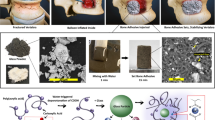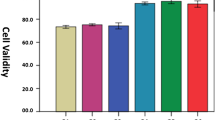Abstract
This work considers a glass polyalkenoate cement (GPC)-based carrier for the effective delivery of bone morphogenetic proteins (BMPs) at an implantation site. A 0.12 CaO–0.04 SrO–0.36 ZnO–0.48 SiO2 based glass and poly(acrylic acid) (PAA, Mw 213,000) were employed for the fabrication of the GPC. The media used for the water source in the GPC reaction was altered to produce a series of GPCs. The GPC liquid media was either 100 % distilled water with additions of albumin at 0, 2, 5 and 8 wt% of the glass content, 100 % formulation buffer (IFB), and 100 % BMP (150 µg rhBMP-2/ml IFB). Rheological properties, compressive strength, ion release profiles and BMP release were evaluated. Working times (Tw) of the formulated GPCs significantly increased with the addition of 2 % albumin and remained constant with further increases in albumin content or IFB solutions. Setting time (Ts) experienced an increase with 2 and 5 % albumin content, but a decrease with 8 % albumin. Changing the liquid source to IFB containing 5 % albumin had no significant effect on Ts compared to the 8 % albumin-containing BT101. Replacing the albumin with IFB/BMP-2 did not significantly affect Tw. However, Ts increased for the BT101_BMP-2 containing GPCs, compared to all other samples. The compressive strength evaluated 1 day post cement mixing was not affected significantly by the incorporation of BMPs, but the ion release did increase from the cements, particularly for Zn and Sr. The GPCs released BMP after the first day, which decreased in content during the following 6 days. This study has proven that BMPs can be immobilized into GPCs and may result in novel materials for clinical applications.





Similar content being viewed by others
References
Pneumaticos SG, Triantafyllopoulos GK, Basdra EK, Papavassiliou AG. Segmental bone defects: from cellular and molecular pathways to the development of novel biological treatments. J Cell Mol Med. 2010;14:2561–9.
Reddi AH. Role of morphogenetic proteins in skeletal tissue engineering and regeneration. Nat Biotechnol. 1998;16:247–52.
Reddi AH. BMPs: from bone morphogenetic proteins to body morphogenetic proteins. Cytokine Growth Factor Rev. 2005;16:249–50.
Bessa PC, Casal M, Reis RL. Bone morphogenetic proteins in tissue engineering: the road from the laboratory to the clinic, part I (basic concepts). J. Tissue Eng Regen Med. 2008;2:1–13.
Niedhart C, Maus U, Redmann E, Schmidt-Rohlfing B, Niethard FU, Siebert CH. Stimulation of bone formation with an in situ setting tricalcium phosphate/rhBMP-2 composite in rats. J Biomed Mater Res A. 2003;65A:17–23.
Bessho K, Carnes DL, Cavin R, Ong JL. Experimental studies on bone induction using low-molecular-weight poly (DL-lactide-co-glycolide) as a carrier for recombinant human bone morphogenetic protein-2. J Biomed Mater Res. 2002;61:61–5.
Mori M, Isobe M, Yamazaki Y, Ishihara K, Nakabayashi N. Restoration of segmental bone defects in rabbit radius by biodegradable capsules containing recombinant human bone morphogenetic protein-2. J Biomed Mater Res. 2000;50:191–8.
Yuan H, de Bruijn JD, Zhang X, van Blitterswijk CA, de Groot K. Use of an osteoinductive biomaterial as a bone morphogenetic protein carrier. J Mater Sci Mater Med. 2001;12:761–6.
Seiya J, Urabe K, Osaki K, Hirata G, Sakai A, Ikenoue T, Iwasmato Y. Intramuscular bone induction by human recombinant bone morphogenetic protein-2 with B-tricalcium phosphate as a carrier, in vivo banking for muscle-pedicle autograft. J Orthop Sci. 2002;7:490–4.
Rai B, Teoh SH, Hutmacher DW, Cao T, Ho KH. Novel PCL-based honeycomb scaffolds as drug delivery systems for rhBMP-2. Biomaterials. 2005;26:3739–48.
Seeherman H, Wozney JM. Delivery of bone morphogenetic proteins for orthopedic tissue regeneration. Cytokine Growth Factor Rev. 2005;16:329–45.
Mehta M, Schmidt-Bleek K, Duda GN, Mooney DJ. Biomaterial delivery of morphogens to mimic the natural healing cascade in bone. Adv Drug Deliv Rev. 2012;64:1257–76.
Langer R, Folkman J. Polymers for the sustained release of proteins and other macromolecules. Nature. 1976;263:797–800.
Luginbuehl V, Meinel L, Merkle HP, Gander B. Localized delivery of growth factors for bone repair. Eur J Pharm Biopharm. 2004;58:197–208.
Autefage H, Briand-Mésange F, Cazalbou S, Drouet C, Fourmy D, Gonçalvès S, Salles J, Combes C, Swider P, Rey C. Adsorption and release of BMP-2 on nanocrystalline apatite-coated and uncoated hydroxyapatite/β-tricalcium phosphate porous ceramics. J Biomed Mater Res B Appl Biomater. 2009;91:706–15.
Xie G, Sun J, Zhong G, Liu C, Wei J. Hydroxyapatite nanoparticles as a controlled-release carrier of BMP-2: absorption and release kinetics in vitro. J Mater Sci Mater Med. 2010;21:1875–80.
Khairoun I, Boltong MG, Driessens FCM, Planell JA. Some factors controlling the injectability of calcium phosphate bone cements. J Mater Sci Mater Med. 1998;9:425–8.
van de Weert M, Hennink WE, Jiskoot W. Protein instability in poly(lactic-co-glycolic acid) microparticles. Pharm Res. 2000;17:1159–67.
Johnson MR, Lee H, Bellamkonda RV, Guldberg RE. Sustained release of BMP-2 in a lipid-based microtube vehicle. Acta Biomater. 2009;5:23–8.
Patel ZS, Yamamoto M, Ueda H, Tabata Y, Mikos AG. Biodegradable gelatin microparticles as delivery systems for the controlled release of bone morphogenetic protein-2. Acta Biomater. 2008;4:1126–38.
Chen S, Shi X, Chinnathambi S, Wu H, Hanagata N. Generation of microgrooved silica nanotube membranes with sustained drug delivery and cell contact guidance ability by using a Teflon microfluidic chip. Sci Technol Adv Mater. 2013;14:015005.
Lane JM, Yasko AW, Tomin E, Cole BJ, Waller S, Browne M, Turek T, Gross J. Bone marrow and recombinant human bone morphogenetic protein-2 in osseous repair. Clin Orthop Relat Res. 1999;361:216–27.
Boontheekul T, Mooney DJ. Protein-based signaling systems in tissue engineering. Curr Opin Biotechnol. 2003;14:559–65.
Fu R, Selph S, McDonagh M, Peterson K, Tiwari A, Chou R, Helfand M. Effectiveness and harms of recombinant human bone morphogenetic protein-2 in spine fusion a: systematic review and meta-analysis. Ann Intern Med. 2013;158:890–902.
Raida M, Clement JH, Leek RD, Ameri K, Bicknell R, Niederwieser D, Harris AL. Bone morphogenetic protein 2 (BMP-2) and induction of tumor angiogenesis. J Cancer Res Clin Oncol. 2005;131:741–50.
Kleeff J, Maruyama H, Ishiwata T, Sawhney H, Friess H, Büchler MW, Korc M. Bone morphogenetic protein 2 exerts diverse effects on cell growth in vitro and is expressed in human pancreatic cancer in vivo. Gastroenterology. 1999;116:1202–16.
Shields LBE, Raque GH, Glassman SD, Campbell M, Vitaz T, Harpring J, Shields CB. Adverse effects associated with high-dose recombinant human bone morphogenetic protein-2 use in anterior cervical spine fusion. Spine. 2006;31:542–7.
Lee KB, Taghavi CE, Murray SS, Song KJ, Keorochana G, Wang JC. BMP induced inflammation: A comparison of rhBMP-7 and rhBMP-2. J Orthop Res. 2012;30:1985–94.
Brown KV, Li B, Guda T, Perrien DS, Guelcher SA, Wenke JC. Improving bone formation in a rat femur segmental defect by controlling bone morphogenetic protein-2 release. Tissue Eng Part A. 2011;17:1735–46.
Wilson AD, Nicholson JW. Acid–base cements: their biomedical and industrial applications. Cambridge: Cambridge University Press; 2005.
Wilson AD, Kent BE. Dental silicate cements: IX. decomposition of the powder. J Dent Res. 1970;49:7–13.
Wren AW, Cummins NM, Coughlan A, Towler MR. The effect of adding organic polymers on the handling properties, strengths and bioactivity of a Ca–Sr–Zn–Si glass polyalkenoate cement. J Mater Sci. 2010;45:3554–62.
Furlan L, de Fávere VT, Laranjeira M. Adsorption of calcium ions by graft copolymer of acrylic acid on biopolymer chitin. Polymer. 1996;37:843–6.
Wren AW, Hansen JP, Hayakawa S, Towler MR. Aluminium-free glass polyalkenoate cements: ion release and in vitro antibacterial efficacy. J Mater Sci Mater Med. 2013;24:1167–78.
Wren A, Boyd D, Towler MR. The processing, mechanical and bioactivity of strontium based glass polyalkenoate cements. J Mater Sci Mater Med. 2008;19:1737–43.
Boyd D, Towler MR, Watts S, Hill RG, Wren AW, Clarkin OM. The role of Sr2+ on the structure and reactivityof SrO–CaO–ZnO–SiO2 ionomer glasses. J Mater Sci Mater Med. 2008;19:953–7.
Redweik S, Cianciulli C, Hara M, Xu Y, Wätzig H. Precise, fast and flexible determination of protein interactions by affinity capillary electrophoresis. Part 2: cations. Electrophoresis. 2013;34:1812–9.
Alhalawani AMF, Curran DJ, Pingguan-Murphy B, Boyd D, Towler MR. A novel glass polyalkenoate cement for fixation and stabilisation of the ribcage, post sternotomy surgery: an ex-vivo study. J Funct Biomater. 2013;4:329–57.
Crisp S, Pringuer MA, Wardleworth D, Wilson AD. Reactions in glass-ionomer cements. II. an infrared spectroscopic study. J Dent Res. 1974;53:1414–9.
Bessa PC, Casal M, Reis RL. Bone morphogenetic proteins in tissue engineering: the road from laboratory to clinic, part II (BMP deliver). J Tissue Eng Regen Med. 2008;2:81–96.
Boyd D, Towler MR, Wren A, Clarkin OM. Comparison of an experimental bone cement with surgical Simplex® P, Spineplex® and Cortoss®. J Mater Sci Mater Med. 2008;19:1745–52.
Carter DR, Hayes WC. Bone compressive strength: the influence of density and strain rate. Science. 1976;194:1174–6.
Bellido T, Ali AA, Plotkin LI, Fu Q, Gubrij I, Roberson PK, Weinstein RD, O´Brein CA, Manolagas SC, Jilka RL. Proteasomal degradation of Runx 2 shortens parathyroid hormone-induced anti-apoptotic signaling in osteoblasts. A putative explanation for why intermittent administration is needed for bone anabolism. J Biol Chem. 2003;278:50259–72.
Boyan BD, Schwartz Z, Swain LD, Khare AG, Heckman JD, Ramirez V, Peters P, Carnes DL Jr. Initial effects of partially purified bone morphogenetic protein on the expression of glycosaminoglycan, collagen, and alkaline phosphatase in nonunion cell cultures. Clin Orthop Relat Res. 1992;278:286–304.
Mayer H, Scutt AM, Ankenbauer T. Subtle differences in the mitogenic effects of recombinant human bone morphogenetic proteins −2 to −7 on DNA synthesis on primary bone-forming cells and identification of BMP-2/4 receptor. Calcif Tissue Int. 1996;58:249–55.
Urist MR, Sato K, Brownell AG, Malinin TI, Lietze A, Huo YK, Prolo DJ, Oklund S, Finerman GA, De Lange RJ. Human bone morphogenetic protein (hBMP). Proc Soc Exp Biol Med. 1983;173:194–9.
Acknowledgments
The authors thank the Natural Sciences and Engineering Research Council of Canada (NSERC) Engage Program (Grant #449,981-13) for facilitating this research.
Author information
Authors and Affiliations
Corresponding author
Rights and permissions
About this article
Cite this article
Alhalawani, A.M.F., Rodriguez, O., Curran, D.J. et al. A glass polyalkenoate cement carrier for bone morphogenetic proteins. J Mater Sci: Mater Med 26, 151 (2015). https://doi.org/10.1007/s10856-015-5494-3
Received:
Accepted:
Published:
DOI: https://doi.org/10.1007/s10856-015-5494-3




